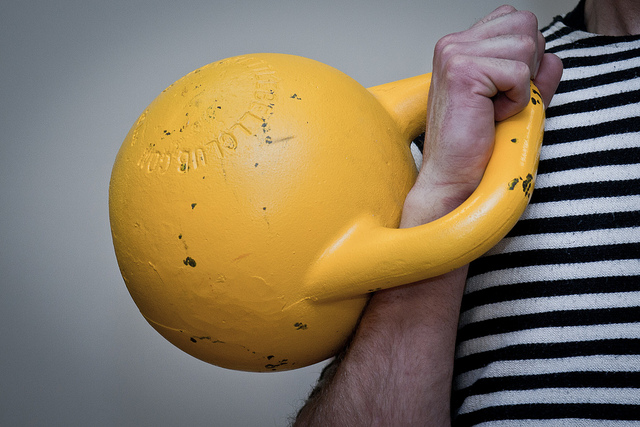Discover the Wonders of Kettlebells

Stuck in an exercise rut? Looking to shake things up a bit? Might I suggest kettlebells? If you haven’t tried them yet, you’re in for a challenging, muscle-building, core-strengthening, sweat-inducing workout.
What, exactly, is a kettlebell?
A kettlebell is a cast-iron ball-shaped weight with a handle attached at the top. They come in a variety of sizes and weights, from light to heavy, and are ideal for men and women of all shapes and fitness levels.
Kettlebells vs. dumbbells
I routinely sing the praises of both, as they each offer an effective workout. How they differ, besides in appearance, is that dumbbells provide a balanced piece of equipment that’s equally weighted on both sides. This gives you greater stability and control over your movements. Kettlebells, on the other hand, are weighted off-center – the handle is light while the ball part is heavy. As you move through exercises, the kettlebell tends to keep going in the original direction, requiring more muscle to redirect it.
How you grip a kettlebell is different as well. Depending on the movement, you tend to use more wrist and forearm power to control it. Let’s take a look at the classic bicep curl as an example. Using a dumbbell, you bend your elbow to lift the weight toward your shoulder. This involves a targeted group of muscles to move the weight in a straight line. When you try a curl with a kettlebell, you need extra muscles to stabilize the movement since the heavier ball part (the weight) starts out hanging below your hand and continues to hang down as you raise your hand toward your shoulder. The kettlebell eventually ends up resting on your forearm. You then need to use your wrist and forearm to control the kettlebell and change the location of the weight to repeat the movement correctly.
What can I do with a kettlebell?
You have plenty of options, depending on which muscle groups you want to target. Here’s a quick rundown of some basic moves.
- Windmill: Targets your shoulders, back, abs, obliques and hips
- Slingshot: Targets back, arms, abs and obliques
- Two-Handed Swing: Targets shoulders, back, hips, glutes and legs
- High Pull: Targets shoulders, arms, glutes and hamstrings
- Lunge Press: Targets shoulders, back, arms, abs, glutes and legs
The benefit from these moves is two-fold: In addition to building muscle strength, you’re also getting a good aerobic workout since you’re constantly moving to keep the kettlebell in motion and control it, as opposed to dumbbells, which pretty much require you to stay stationary.
Plus, the thick handles of the kettlebell strengthen your grip, and the position of the weight in relation to the handle challenges your core. In fact, everything has to work harder than if you were using a dumbbell, so you get more out of even standard dumbbell moves, such as bicep curls, dead lifts, shoulder presses, tricep extensions, bent-over rows, etc. This extra muscle activity means your body will burn more calories. Just make sure you master these moves before increasing the weight.
As with all exercises, proceed with caution
I cannot emphasize this last point enough: Make sure you take a beginner class or schedule a tutorial with a fitness professional before you start using kettlebells. As I mentioned before, they’re not the same as dumbbells and the movements require some practice and repetition under the watchful eye of an expert before you’re ready to use them on your own. The last thing I want is for anyone to get hurt.
Take a free fitness class
CDPHP® is constantly changing and enhancing its free fitness class listing to offer members new and fun classes that challenge the body and mind. You might even find a beginner kettlebell class in the fitness category from time to time.
I hope this little introduction to kettlebells inspires you to try them or even make them a part of your regular fitness routine. With continued use, you’ll see an increase in muscle strength, definition, and tone; a leaner figure; improved functionality (e.g., picking up a child, carrying a heavy grocery bag); a stronger grip; potential weight loss and improved posture since you’re constantly engaging your core. What more could you ask for? Good luck and happy swinging!
Photo by Andrew Malone / CC BY
 The Daily Dose
The Daily Dose
Comments are closed.